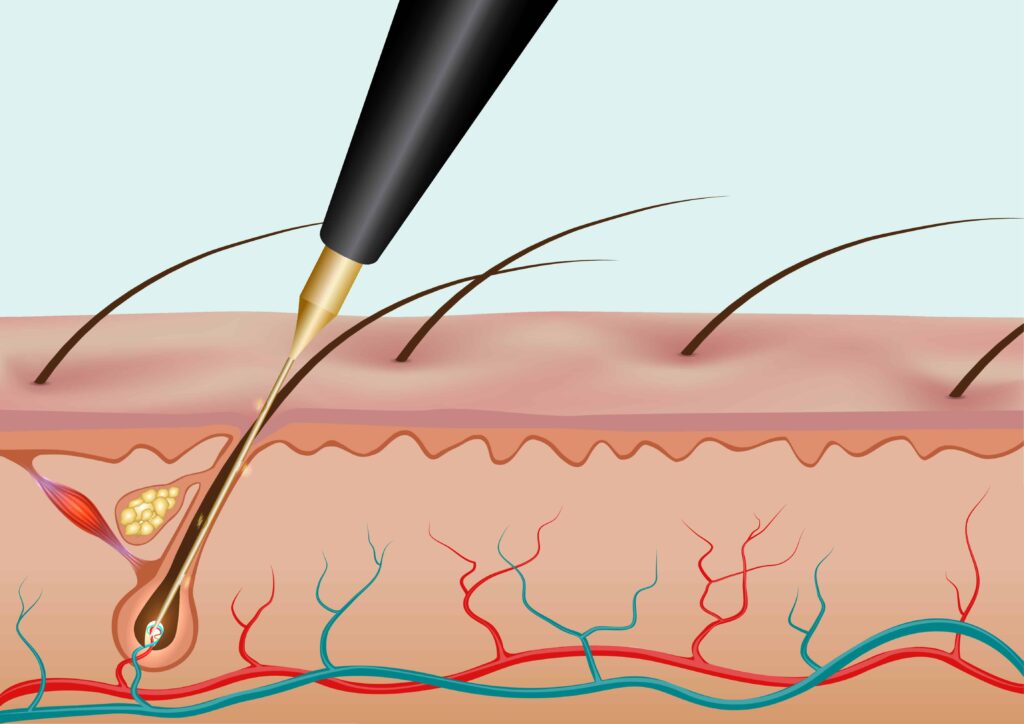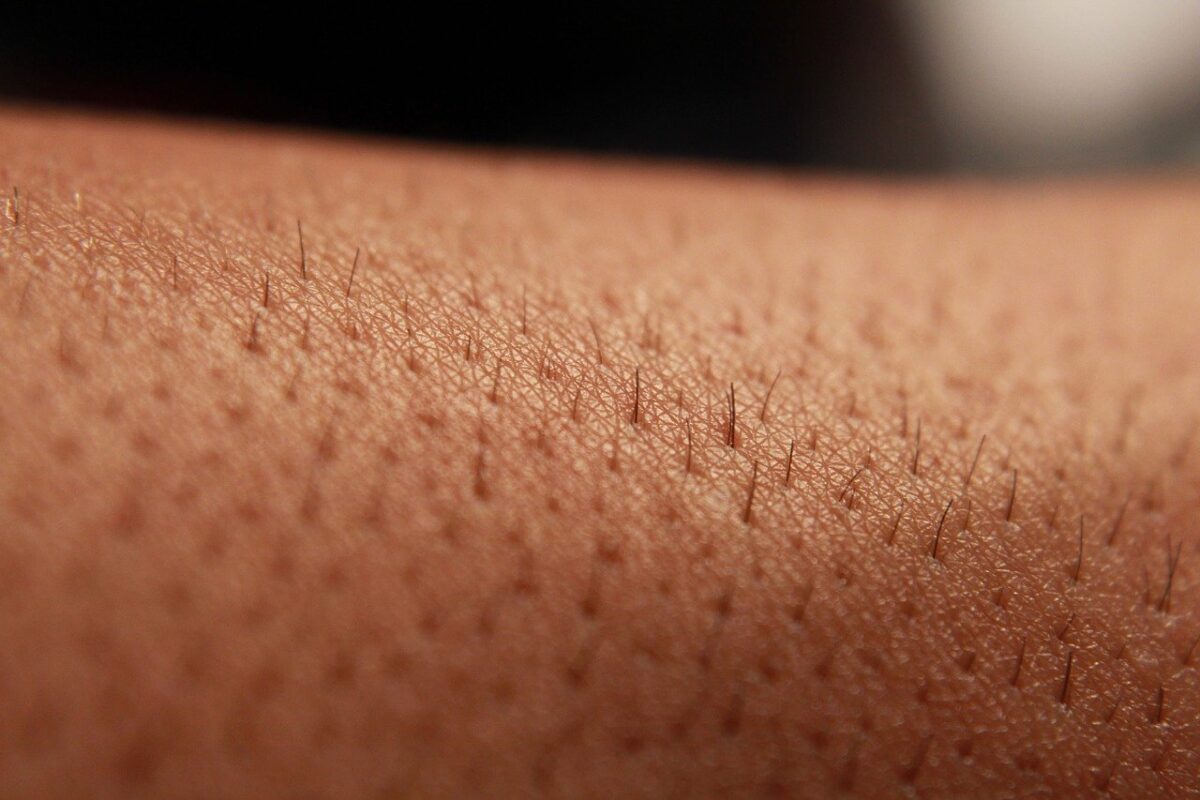Here is a Q & A with Dan Wallace, a Dallas, Texas-based electrologist who specializes in electrolysis for men. Be sure to check out Dan’s website for more information regarding his services.
Below in the Q & A, Dan answers all my questions regarding electrolysis including the process described in detail, why it’s not just for women, how to choose an electrologist and why it’s the only true permanent hair removal option available.
What is electrolysis hair removal?
Electrolysis hair removal is a process that uses a tiny probe to apply an electrical current at the base of the hair.
The term electrolysis actually refers to three types of treatment, called modalities. Galvanic is the original method that uses a direct electrical current. Direct current is the type of electrical current that a battery supplies. A probe is inserted into the follicle with the tip of the probe beside the base of the hair. When a direct current is applied to the base of the hair, the current stimulates a chemical reaction between the water and the salt in the hair follicle to create sodium hydroxide (lye). The galvanic modality is a chemical process.
In the 1940’s, a new type of treatment was developed that uses an alternating electrical current. This modality is called thermolysis. Alternating electrical current if the type of electricity we use in our houses within the USA. It’s called alternating because the positive and negative poles switch back and forth. The speed at which they do this is called the frequency. When an alternating electrical current is applied via a probe to the base of the hair, molecules vibrate against each other generating a burst of heat. The higher the frequency, the faster the treatment can be applied. Modern epilators operate at very high frequencies and can treat a hair follicle in a few thousandths of a second using thermolysis. The thermolysis modality is a heat process.
The third modality is called blend. It is called blend because it combines both galvanic and thermolysis modalities. Both the galvanic modality and thermolysis are applied to the base of the hair..
Hair type usually determines which type is of modality is used. Pure galvanic is the least used modality, and thermolysis is the most used.

How is electrolysis hair removal different from laser?
With electrolysis hair removal, a probe is inserted into the follicle beside the base of the hair. An electrical current is then applied, destroying the dermal papilla. Each follicle is treated. Electrolysis hair removal can treat all types and colors of hair. Skin type does not make a difference. Electrolysis hair removal is great for detailed work, such as shaping eyebrows or beard lines. With electrolysis hair removal, the treatment is below the skin surface eliminating any chance of damaging the skin.
Laser hair removal uses a medical laser to apply heat to the surface of the skin and that heat flows down the follicle. Laser is able to treat large areas quickly. Hair color and skin type can impact the effectiveness of treatment. Typically, laser hair removal is not very effective on blonde or gray hair.
Many people use both types of hair removal. Depending on hair and skin types, a person may begin with laser hair removal and then finish up with electrolysis. A person with gray hair will definitely need electrolysis.
Why is electrolysis hair removal permanent? Will the hair grow back after treatment?
Effective electrolysis hair removal treatment destroys the dermal papilla, the source of nutrition of a hair. If the hair cannot get nutrition, it cannot grow.
The base of the hair is commonly called the root, but electrologists often call it the base or matrix. It is slightly concave at the bottom and sits on top of a group of cells called the dermal papilla. If the dermal papilla is destroyed, a hair cannot grow. The electrologist slides a probe down to the base of the hair, applies an electrical current, and destroys the dermal papilla. That hair cannot grow back.
But I had electrolysis hair removal and it looked like the hair eventually grew back. Why was that?
Hair that is effectively treated does not grow back. But, other hair follicles in the area may produce hair. This may be because vellus hair (peach fuzz) transitions to adult hair; or, it may be that neighboring hair is coming out of its resting, or dormant, stage. Not all hair follicles express a hair at all times. During treatment, you can distinguish between new growth and re-growth by observing the tip of the hair. If it tapers to a tip, it is new growth. If it has a blunt tip, it is re-growth.
When we are young most of the hair on our bodies is the light peach fuzz kind of hair. That is called vellus hair. As children, the only dark, adult-type hair we have is on our scalps, eyebrows and eyelashes. This hair is sometimes called native hair.
When we hit puberty and hormones start circulating through our bodies, one particular hormone, testosterone, can cause some of the vellus hair to convert to the adult type of hair, which is called terminal hair. It is called terminal because it has reached its final, or terminal, stage of development. As teenagers, we witness this change in our bodies as we develop terminal hair in our underarms, on our legs, our faces (if you’re a man) and other areas.
But, only the vellus hair most sensitive to the testosterone converts during our teens. Fortunately, a relatively small percentage of the vellus hair transitions to terminal hair. As we age, however, vellus hair continues transitioning to terminal hair because of the constant, long-term exposure to the hormone. This is why men develop hair on their ears as they grow older. Sometimes women may develop hair on their faces.

You said not all hair follicles express a hair at all times. What do you mean by that?
Hair, whether native or terminal, goes through a three-stage process. During the actively growing stage, we see the hair. But during the resting, or dormant, stage, the follicle may not have a hair.
The three stages of hair growth are anagen, catagen and telogen. The anagen stage is the actively growing stage, when the hair follicle is the deepest. The hair is resting on the dermal papilla. It is during this stage that a hair can be effectively treated and the dermal papilla destroyed.
Eventually the hair follicle enters a transition stage called the catagen stage. In this stage, the hair may continue to grow as it uses up stored resources in the base, but the base is detaching from the dermal papilla and the nutrition source is being removed. The hair follicle begins growing shorter.
Finally, the hair follicle enters the resting stage known as the telogen stage. Usually the hair falls out and the hair follicle isn’t obvious. It is not possible to treat hair in the telogen stage. How long the hair follicle remains in the telogen stage varies with different areas of the body. Eventually, the follicle leaves the telogen stage, enters the anagen stage again, and produces a hair.
About 70% to 80% of the hair follicles on your scalp are in the anagen stage, actively growing. 20% to 30% are in the catagen or telogen stages. But your eyebrows? Only 15% to 20%of the follicles are actively growing hair in the anagen stage. 80% to 85% are resting. These ratios vary with different areas of the body.
Does electrolysis hair removal hurt?
Regardless of which electrolysis hair removal modality is being used, the client will feel a sensation. My clients tell me that, depending on the area being treated, the sensation is less than many other methods of hair removal, such as tweezing, waxing or laser. It’s not uncommon for clients to fall asleep during treatment.
A number of factors determine whether the client will experience a mild sensation or a painful sensation. One factor is an individual’s pain tolerance. It varies from person to person. Some people have a very high pain tolerance, some a very low one.
Another factor is where the treatment area is located. A man’s shoulders are often one of the least sensitive areas to work, while a woman’s upper lip is the most sensitive. Fingers and toes are very sensitive, but the chin area is much less sensitive.
Some of the other factors include the type of electrolysis hair removal modality being used, has the client exercised recently, has the client consumed alcohol recently.
There are a number of topical anesthetics available which can temporarily reduce the sensation of treatment. There are now over-the-counter medications that have 5% lidocaine. Stronger anesthetic creams are available by prescription. These creams are typically applied 45 to 60 minutes before treatment. It is important to read the directions and use care with these creams. For example, lidocaine can affect the heart if too much is applied.
I find it interesting that many of my clients ask me on their third or fourth visit if I am using the same settings as on previous visits. I am. They seem to have developed a greater tolerance to the treatment. I think it has to do with the body’s production of endorphins. Endorphins are the body’s natural painkillers. It seems that the endorphins are having a greater effect by the third or fourth visit.
What are the short-term and long-term side effects of electrolysis hair removal?
Electrolysis hair removal breaks down some of the cells at the base of the hair, including the dermal papilla. When the cell walls are destroyed, fluid is released under the skin. This is called edema, and it causes a small bump on the surface of the skin, much like a mosquito bite. There is also some redness. I ask my clients to report back on how long it takes for the bump and the redness to go away. I prefer that the bump and the redness be gone in 30 minutes, an hour at the maximum. If it takes longer than that, I try different probes and treatment settings. Some people’s skin is simply more sensitive to treatment.
Since the electrolysis hair removal treatment is kept below the surface of the skin, there are no long- term effects of treatment. There should not be any weeping from the follicles or scabbing after treatment.
Is electrolysis hair removal just for women or can men benefit from it as well?
Our culture has some definite ideas about hair, and these ideas change and evolve over time. When we meet someone, we subconsciously make assumptions about that person based on his/her grooming habits. Is the scalp hair clean and cut? On a man, is he clean- shaven or bearded? Does he have a unibrow? Hairy ears? Does he have hair peeking out of his collar? If a woman is in a sleeveless blouse, are her underarms smooth? How about her legs?
Many women have always felt that they needed to shape eyebrows, remove facial hair and shave their underarms and legs. Electrolysis offers permanent hair removal solutions for those areas.
More and more, as our culture’s ideas about grooming evolve, men are expected to consider expanding their grooming habits. A man with a unibrow can have it shaped into two eyebrows. Older men with hair on their ears can have the hair removed. Beard lines can be shaped. Men can have hair removed from their necks and backs.
If a man has a problem with ingrown beard hairs, electrolysis can help him.
By and large, it is no longer considered effeminate for a man to practice good grooming in all areas of his body. My client list includes professional athletes, CEOs and sportsmen. Often, male clients are referred to me by their wives. Male clients are often anxious during their first visit. Once they realize that many other men are receiving the same treatments, they relax.
Our culture has expanded its ideas of good grooming to more intimate areas of our bodies. For quite a long time, women have groomed the hair in the pubic area. Now, however, men are also expected to practice good grooming in that area. At the least, they are often expected to trim the pubic hair. If a man has hair on his penis, he is increasingly expected to remove it, one way or another. Some men also shave the hair on the scrotum. Electrolysis can treat the hair permanently in all these areas. It is not as painful as a man might expect, and clients tell me it isn’t nearly as painful as plucking the hair.
What parts of the body are good candidates for electrolysis hair removal?
Electrolysis can be performed on hair on all areas of the body with two exceptions. Electrolysis cannot be performed inside the nose or inside the ear canal. That is because those areas have mucus membranes that might be damaged by treatment.
How many treatments are typically required to completely remove all unwanted hair in a particular area? What will the cost be?
This is a difficult question to answer because everybody is different. The number of treatments required determines the cost. Some of the factors affecting the amount of time it will take to clear an area include:
– Some people want total clearance of all the hair, whereas other people only want the thicker, darker hair removed.- One male client may have 15 hair follicles per square inch that need treatment, while another has 50 per square inch. – A client’s pain tolerance affects the types of treatment that may be used.- Treatment progresses faster in some areas of the body than others because of the depth of the hair follicles.
There are charts that list estimated treatment times for various areas of the body. I personally don’t feel comfortable generalizing like that because people are so different in regards to their hair types. I usually ask a client to have two or three appointments and then let me address that question. By then I’ve determined what the effective treatment settings are, I’ve seen how a client responds to treatment and I can offer guidance regarding the time/cost to treat the area.
The goal is to get a client into maintenance mode where an occasional visit will clear out any new hair growth.
What sort of training does an electrolysis practitioner receive?
The two primary types of training are electrolysis schools and master/apprentice training. If a person attends an electrolysis school and completes training, that person is then able to take a certification examination. Different schools offer curriculums of varying lengths of time. There is also at least one Internet/online school offering electrolysis training.
If a person pursues an apprenticeship program, that person will work with a certified electrologist and must meet the study/training requirements of the organizations that offer certification examinations. Curriculum requirements are stringent, specifying study materials, length of training time, etc. Once a person meets those requirements, he/she may apply to take the certification exam.
Performing effective electrolysis is more difficult than one might think. It was more difficult than I thought it would be. Regardless of which training method a person chooses, that person must be prepared to study hard and practice diligently.
For more information, please check out these websites:
American Electrology Association (Electrolysis only)
(Electrolysis only)
Society for Clinical and Medical Hair Removal (Electrolysis and Laser)
(Electrolysis and Laser)
How can I ensure I choose a good electrolysis hair removal professional?
The best way, of course, is to get a referral from someone who is pleased with his/her electrologist. This isn’t always possible, however. So, you may need to schedule a consultation with an electrologist.
When you go to a consultation, be prepared to both listen and ask questions. Here are the topics I cover during a consultation:
-An explanation of what electrolysis is and how it works. I have some visual aids on the walls of my office that I use, such as diagrams of hair follicles. I think it is important that a client understand the process.
-An explanation of what a person may feel during treatment, including a discussion of topical skin anesthetics.
-Review possible after affects of treatment and post treatment care.
-Explain our office sterilization and sanitation practices. Sterilization and sanitation is very important. For example, current standards require the use of pre-sterilized, single use, disposable probes.
-I discuss my training, certification and experience.
-I do sample treatment in the area to let the client experience treatment and to allow me to begin determining the correct treatment settings.
After treatment, there should be no fluids weeping from the hair follicles and there should be no scabbing of the hair follicles.
A big thank you to Dan Wallace for his expertise and time. If you’re in the Dallas area and are considering electrolysis or just want more information regarding Dan and his services, you can visit Dan’s website Electrolysis For Men .
.
Recent Posts
Laser hair removal may not be as effective for individuals with red hair, as well as those with blonde, gray, or white hair, because the laser targets the pigment (melanin) in the hair follicle....
Laser remains a very popular form of hair removal and for several reasons. While not a permanent hair removal option like electrolysis, the benefit of laser is that it enables you to treat more...


